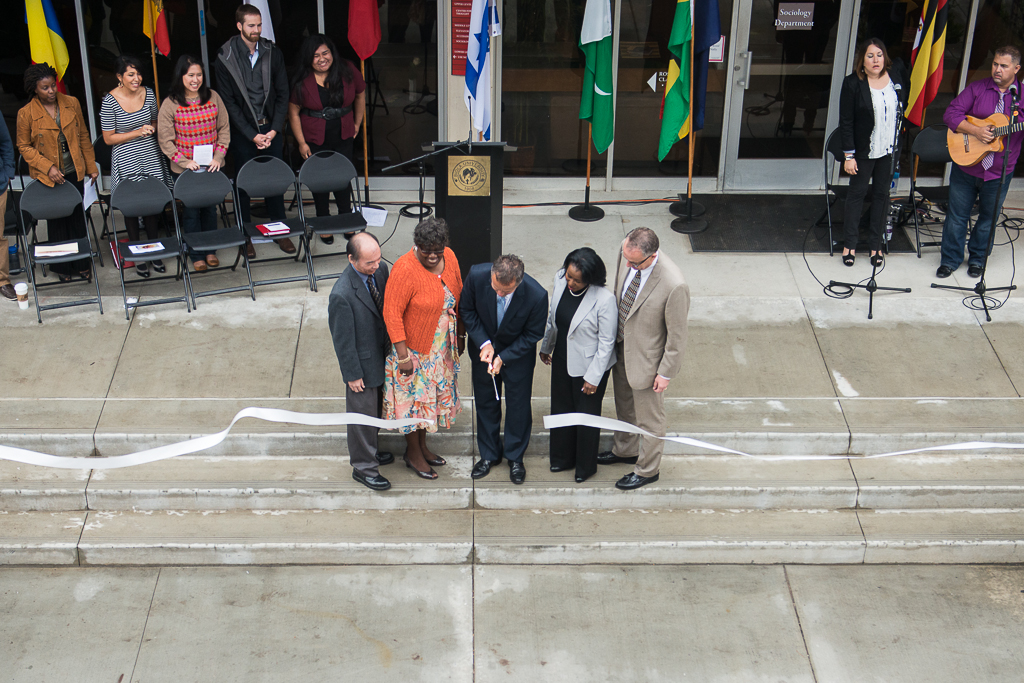
As part of an ongoing focus on diversity and cross-cultural interactions, the Mosaic Cultural Center in Rose Hall opened its doors on Monday. The facility will serve as a workspace for Multi-Ethnic Programs and Development and the Center for Cross-Cultural Engagement, as well as a common area for students and faculty to engage in discussion.
“For any university, it’s great to have a place you can have those safe as well as challenging conversations regarding diversity and regarding cross-cultural engagement,” said Gail Buck, director of the Center for Cross-Cultural Engagement.
Many students and faculty attended the ribbon-cutting ceremony Monday morning, including senior sociology major Brian Clements.
“This is a big day for everybody here whether they know it or not. It is a bridge to new perspectives and I think a growing understanding of what it means to live in real community with one another,” Clements said.
Buck, who began her work as the first director of CCCE only seven months ago, explained that the center will be a launch pad for several new initiatives to encourage Biolans to interact with different cultures. One of these initiatives is community-based learning, an education method that brings real-life experience into traditional learning.
The idea of community-based learning is to transfer knowledge learned in a classroom setting into real-life experiences, according to Buck. But the learning process does not stop there.
“And then … the students themselves who are serving will bring that back to the classroom, and they will see that what they learned in that book or that lecture comes alive in the field,” she said.
To jumpstart this process, the Mosaic Cultural Center will aid six faculty taking part in a pilot program to learn more about diversity and community-based learning. The trial program will kick off this summer and last until May 2014, at which time it will be evaluated.
In addition to serving the campus, the center will also be used to interact with outside organizations working to promote cross-cultural learning opportunities. Buck gave the example of Solidarity, a Fullerton-based organization that specializes in working with after school programs and children in immigration detention.
“[The center is] also a home for our community-based partners to come in and work with our students and faculty to give presentations as to what they’re doing,” she said.
The initial idea for Mosaic did not stem from a single source, according to Glen Kinoshita, director of MEPD. Rather, the center is the culmination of many people’s dreams and ideas, including students.
“It’s obviously carried by the need for a place for students to come to engage with one another … and who want to grow in cross-cultural understanding,“ Kinoshita said.
While cultural centers thrive on secular college campuses like those of the University of Washington or the University of California, Berkeley, Christian colleges have been slower to embrace diversity with quite the same gusto, according to Kinoshita.
“In Christian colleges in general, diversity has been lacking and falling behind national trends,” he said. In a 2010 Forbes study that analyzed the most ethnically diverse colleges in the nation, nearby California State University, Fullerton boasted a 55 percent minority rate out of the entire student body, while Biola has a caucasian majority of 59 percent.
Although there are many possible causes of this imbalance, Kinoshita said he suspects it is partially due to the ethnic homogeneity experienced by Christian churches.
“It has been said by many people that 11 a.m. on Sunday morning is still the most segregated hour,” he said. “And as a result, I think that Christian colleges still reflect that reality.”
Clements agreed that diversity is a necessary but lackluster part of Biola’s campus culture.
“Diversity is [an] extremely important aspect of the Christian life. … It’s not very well-represented here on campus,” he said. “This building is very symbolic of those things, and the community that’s going to be built from it.”
Kinoshita hopes that Mosaic will not only be a place that impacts students’ hearts, but also their academic growth.
“It’s to create a community to make Biola a place that embraces people in a growth process … [Students] find one another, they grow with one another and they teach one another through their stories,” he said. “Diversity enhances the learning environment.”







